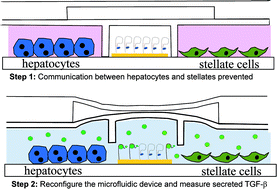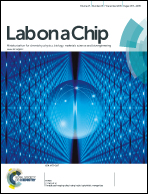Liver injury-on-a-chip: microfluidic co-cultures with integrated biosensors for monitoring liver cell signaling during injury†
Abstract
Tissue injury triggers complex communication between cells via secreted signaling molecules such as cytokines and growth factors. Discerning when and where these signals begin and how they propagate over time is very challenging with existing cell culture and analysis tools. The goal of this study was to develop new tools in the form of microfluidic co-cultures with integrated biosensors for local and continuous monitoring of secreted signals. Specifically, we focused on how alcohol injury affects TGF-β signaling between two liver cell types, hepatocytes and stellate cells. Activation of stellate cells happens early during liver injury and is at the center of liver fibrosis. We demonstrated that alcohol injury to microfluidic co-cultures caused significantly higher levels of stellate cell activation compared to conditioned media and transwell injury experiments. This highlighted the advantage of the microfluidic co-culture: placement of two cell types in close proximity to ensure high local concentrations of injury-promoting secreted signals. Next, we developed a microsystem consisting of five chambers, two for co-culturing hepatocytes with stellate cells and three additional chambers containing miniature aptamer-modified electrodes for monitoring secreted TGF-β. Importantly, the walls separating microfluidic chambers were actuatable; they could be raised or lowered to create different configurations of the device. The use of reconfigurable microfluidics and miniature biosensors revealed that alcohol injury causes hepatocytes to secrete TGF-β molecules, which diffuse over to neighboring stellate cells and trigger production of additional TGF-β from stellate cells. Our results lend credence to the emerging view of hepatocytes as active participants of liver injury. Broadly speaking, our microsystem makes it possible to monitor paracrine crosstalk between two cell types communicating via the same signaling molecule (e.g. TGF-β).

- This article is part of the themed collection: Nanoengineering for Medicine and Biology (NEMB 2015)

 Please wait while we load your content...
Please wait while we load your content...